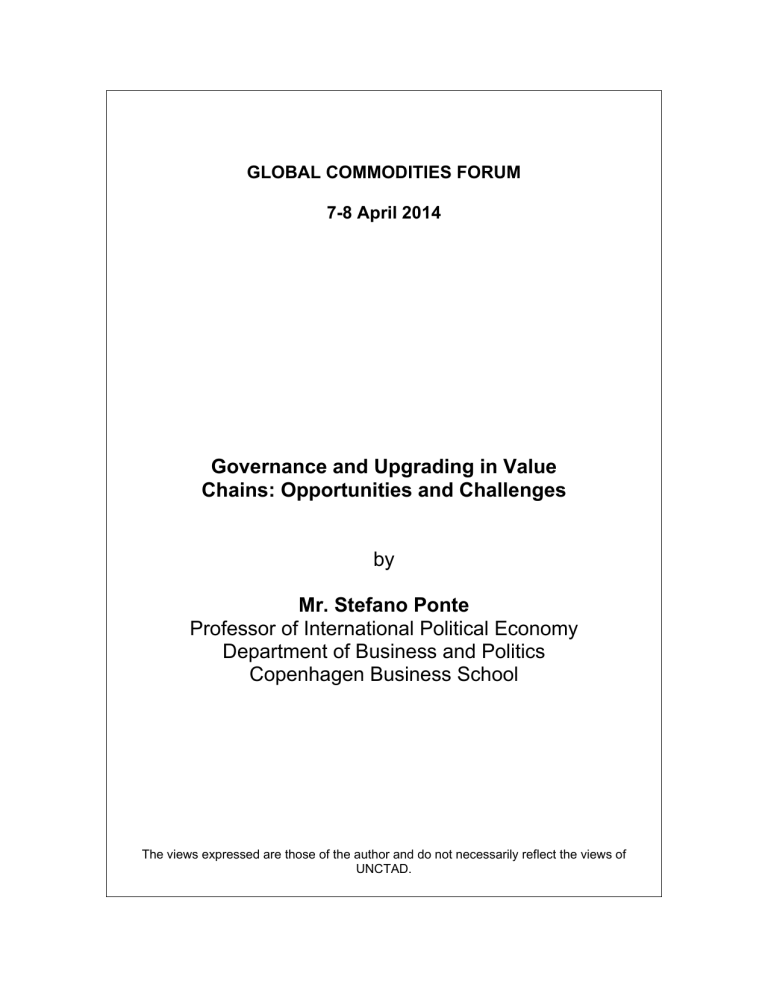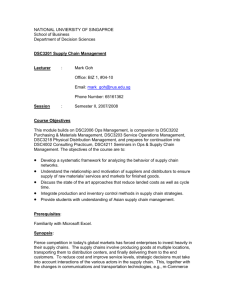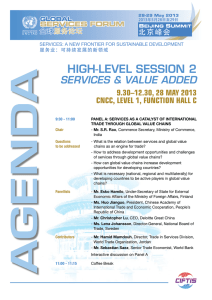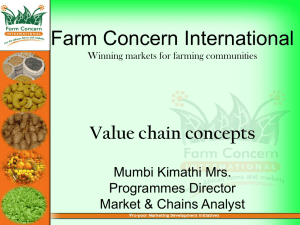Governance and Upgrading in Value Chains: Opportunities and Challenges Mr. Stefano Ponte

GLOBAL COMMODITIES FORUM
7-8 April 2014
Governance and Upgrading in Value
Chains: Opportunities and Challenges by
Mr. Stefano Ponte
Professor of International Political Economy
Department of Business and Politics
Copenhagen Business School
The views expressed are those of the author and do not necessarily reflect the views of
UNCTAD.
Governance
and
Upgrading
in
Value
Chains:
Opportunities
and
Challenges
Stefano Ponte
Professor of International Political Economy
Department of Business and Politics
Copenhagen Business School
Presented at GCF, 7 April 2014
11. September 2013 | Side 1
Outline
•
Why
value
chains
•
Governance
of
value
chains
•
Value
chain
upgrading
•
Sustainability
standards
and
transparency
•
Value
chain
interventions
•
Conclusion
11. September 2013 | Side 2
Why
value
chains?
• Last 20 years
– From trade in products to trade in tasks/value added
– From vertically ‐ integrated TNCs to governing of various layers of suppliers
– End of commodity agreements as ways of co ‐ governing trade + market liberalization
• More recently, increased focus on
– ’Learning from buyers’
– Industrial policy and building (specific) productive capacity
11. September 2013 | Side 3
Value
chains
• Full range of activities that are required to bring a product or service from conception, through different phases of production and processing, delivery to final consumers and final disposal/recycling
• Can be global, regional, local
11. September 2013 | Side 4
Figure 3.
Generic Value Chain Map
EXPORT Channel
CONSUMER
OUTLET
TRADER
AGRO ‐ FOOD
PROCESSING
PRODUCER
INPUT SUPPLY
Inernational consumer segment
International supermarket
Wholesaler
LOCAL Channel
Local consumers
Local supermarket
Restaurants Street vendors
International trader Local traders Financial services
Large ‐ size processor
Contract
national outgrowers
Large ‐ scale producer
Farming cooperative with integrated postharvest handling and agro ‐ food processing
SME processors
Local smallholder
Large ‐ size national supplier
International supplier
Marketing services
Small ‐ size local
Technical services
11. September 2013 | Side 5
Value chain governance
• Actively governed, rarely true ’markets ’
• Lead firms govern value chains through specific demands
(buyer power), rarely through direct ownership
• Eg retailers (Wal-Mart, Tesco, etc.)
• Branded processors (Nestle’, Unilever)
• International traders (Cargill, ADM)
• Driving mechanisms
• Buyer-driven, producer-driven value chains
• Different linkages along the value chain
• Market, Modular, Relational, Captive, Hierarchy
11. September 2013 | Side 6
Value chain participation
• Does it work for for actors in CDDCs?
• Important to understand:
– how GVC inclusion and exclusion take place
– under what conditions and rewards
– opportunities and threats, risk and vulnerability
• Depends on:
– What value chain?
Which lead firms?
– What forms of governance and linkages?
– What standards are required?
• Food safety, quantity, quality, volume, logistics, time ‐ to ‐ market
• Sustainability certifications
11. September 2013 | Side 7
Institutional and economic frameworks, regulation
Chain actors
Export node
Vertical linkages (contracts, flows of products, information, inputs)
Primary processing/trading node
Production node
Horizontal impacts on participants and
| Side 8 non participants and their communities
Upgrading in value chains
• Different possibilities
:
– make better products
– improve processes
– add functions
– receive higher prices for the same product (FT, GIs)
– match standards, logistics, volume, timing demands
– provide wider portfolio of product qualities
11. September 2013 | Side 9
Sustainability standards and transparency
• Becoming increasingly demanded by ‘buyers’
• Adding transparency on conditions of production
• BUT, also placing extra demands on producers and small enterprises in developing countries
– can be costly
– (often paid by donors, NGOs, exporters)
• Often not paying a premium at the farm gate
– Offer entry point to a market or buyer
11. September 2013 | Side 10
Value chain interventions
• creating new value chains;
• increasing the capabilities of target groups to improve the terms of value chain participation
– also through collective action
– leverage points
• minimizing the possible negative impacts of value chain operations on non ‐ participants and/or adjacent communities
11. September 2013 | Side 11
Value chain interventions (cont)
• Strengthening vertical links
– e.g.
between farmers and agro ‐ food processors or exporters
– contract farming
– improved information on product forms, prices, quality
• Addressing bottlenecks in the value chain
– inputs, logistics, cold chain, technology, infrastructure
• Develop productive capacity
• Support in meeting standards & certification
11. September 2013 | Side 12
Conclusion
• Opportunities and challenges in:
– value chain participation
– upgrading trajectories
• Answer is not always in ‘trading up’
– volume still important, wider portfolios (including lower quality), emerging markets
• Regulation and donor/public sector support
– important but needs to be devised in view of actual functioning and governance of value chains
11. September 2013 | Side 13







